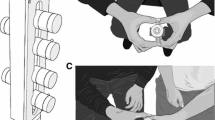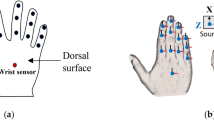Abstract
We studied multi-digit synergies as relations among digit forces and points of their application across multiple repetitions of a static prehensile task. The task required holding a grasped object (14.9 N) against different external torques. Subjects (n=6) performed 25 trials for each torque condition: –1.0, –0.5, 0, +0.5 and +1.0 Nm. In spite of the variability of individual forces and points of their application, stable performance was achieved. Individual performance variables were organized into two subsets. Variables within each subset highly correlated with each other (the coefficients of correlation were close to ±1.0) while there was no correlation among variables from different subsets. The two subsets were associated with two components of the prehension task: grasp control (preventing an object from slipping out of the hand) and torque control (maintaining a desired object orientation).








Similar content being viewed by others
References
Arimoto S, Nguyen PTA (2001) Principle of superposition for realising dexterous pinching motions of a pair of robot fingers with soft-tips. IEICE Transactions on Fundamentals of Electronics Communications and Computer Sciences E84A:39–47
Arimoto S, Tahara K, Yamaguchi M, Nguyen PTA, Han HY (2001) Principles of superposition for controlling pinch motions by means of robot fingers with soft tips. Robotica 19:21–28
Baud-Bovy G, Soechting JF (2001) Two virtual fingers in the control of the tripod grasp. J Neurophysiol 86:604–615
Baud-Bovy G, Soechting JF (2002) Factors influencing variability in load forces in a tripod grasp. Exp Brain Res 143:57–66
Bernstein NA (1967) The Co-ordination and Regulation of Movement. Pergamon Press, Oxford
Burstedt MK, Birznieks I, Edin BB, Johansson RS (1997) Control of forces applied by individual fingers engaged in restraint of an active object. J Neurophysiol 78(1):117–128
Burstedt MK, Flanagan JR, Johansson RS (1999) Control of grasp stability in humans under different frictional conditions during multidigit manipulation. J Neurophysiol 82:2393–2405
Cole KJ, Abbs JH (1986) Coordination of three-joint digit movements for rapid finger-thumb grasp. J Neurophysiol 55:1407–1453
Cole KJ, Abbs JH (1987) Kinematic and electromyographic responses to perturbation of a rapid grasp. J Neurophysiol 57:1498–1510
Cole KJ, Abbs JH (1988) Grip force adjustments evoked by load force perturbations of a grasped object. J Neurophysiol 60:1513–1522
Cole KJ, Johansson RS (1993) Friction at the digit-object interface scales the sensorimotor transformation for grip responses to pulling loads. Exp Brain Res 95:523–532
Cole KJ, Rotella DL, Harper JG (1999) Mechanisms for age-related changes of fingertip forces during precision gripping and lifting in adults. J Neurosci 19:3238–3247
Cutkosky MR, Howe RD (1990) Human grasp choice and robotic grasp analysis. In: Venkataraman T, Iberall T (eds) Dextrous Robot Hands. Springer, Berlin Heidelberg New York, pp 5–31
Edin BB, Westling G, Johansson RS (1992) Independent control of human finger-tip forces at individual digits during precision lifting. J Physiol 450:547–564
Eliasson AC, Forssberg H, Ikuta K, Apel I, Westling G, Johansson, R (1995) Development of human precision grip. V. Anticipatory and triggered grip actions during sudden loading. Exp Brain Res 106(3):425–433
Figliola RS, Beasley DE (2000) Theory and Design for Mechanical Measurements, 3rd edn. John Wiley & Sons, New York
Flanagan JR, Wing AM (1995) The stability of precision grip forces during cyclic arm movements with a hand-held load. Exp Brain Res 105(3):455–64
Flanagan JR, Wing AM (1997) The role of internal models in motion planning and control: evidence from grip force adjustments during movements of hand-held loads. J Neurosci 17:1519–1528
Flanagan JR, Burstedt MK, Johansson RS (1999) Control of fingertip forces in multidigit manipulation. J Neurophysiol 81:1706–1717
Fullerton GS, Carttell JMcK (1892) On the perception of small differences. (Philosophical Monograph Series No. 2). University of Pennsylvania Press, Philadelphia, PA
Hager-Ross C, Cole KJ, Johansson RS (1996) Grip-force responses to unanticipated object loading: load direction reveals body- and gravity-referenced intrinsic task variables. Exp Brain Res 110:142–150
Hermsdorfer J, Marquardt C, Philipp J, Zierdt A, Nowak D, Glasauer S, Mai N (1999) Grip forces exerted against stationary held objects during gravity changes. Exp Brain Res 126(2):205–14
Hogan N (1984) An organizational principle for a class of voluntary movements. J Neurosci 4:2745–2754
Iberall T (1997) Human prehension and dexterous robot hands. International Journal of Robotics Research 16:285–299
Johansson RS (1996) Sensory and memory information in the control of dexterous manipulation. In: Lacquaniti F, Viviani P (eds) Neural Bases of Motor Behavior. Kluwer Acad Publ, Amsterdam, pp 67–79
Latash ML, Scholz JF, Danion F, Schöner G (2001) Structure of motor variability in marginally redundant multi-finger force production tasks. Exp Brain Res 141:153–165
Latash ML, Scholz JF, Schöner G (2002a) Motor control strategies revealed in the structure of motor variability. Exer Sport Sci Rev 30:26–31
Latash ML, Scholz JF, Danion F, Schöner G (2002b) Finger coordination during discrete and oscillatory force production tasks. Exp Brain Res 146:412–432
Latash ML, Kang N, Patterson D (2002c) Finger coordination in persons with Down syndrome: atypical patterns of coordination and the effects of practice. Exp Brain Res 146(3):345-55
Li ZM, Latash ML, Zatsiorsky VM (1998) Force sharing among fingers as a model of the redundancy problem. Exp Brain Res 119:276–286
MacKenzie CL, Iberall T (1994) The Grasping Hand. North Holland, Amsterdam
Michon JA (1967) Timing in temporal tracking. Institute for Perception RVO-TNO, Sesterberg, The Netherlands
Nelson W (1983) Physical principles for economies of skilled movements. Biol Cybern 46:135–147
Newell KM, Carlton LG, Hancock PA (1984) Kinetic analysis of response variability. Psychol Bull 96:133–151
Nowak DA, Hermsdorfer J, Glasauer S, Philipp J, Meyer L, Mai N (2001) The effects of digital anaesthesia on predictive grip force adjustments during vertical movements of a grasped object. Eur J Neurosci 14:756–762
Prilutsky BI, Zatsiorsky VM (2002) Optimization-based models of muscle coordination. Exercise and Sport Sciences Reviews 30(1):32–38
Rearick MP, Santello M (2002) Force synergies for multifingered grasping: effect of predictability in object center of mass and handedness. Exp Brain Res 144:38–49
Rearick MP, Casares A, Santello M (2003) Task-dependent modulation of multi-digit force coordination patterns. J Neurophysiol 89:1317–1326
Rumann WS (1991) Statically Indeterminate Structures. Wiley-Interscience, New York
Santello M, Soechting JF (1997) Matching object size by controlling finger span and hand shape. Somatosens Mot Res 14(3):203–12
Santello M, Soechting JF (2000) Force synergies for multifingered grasping. Exp Brain Res 133:457–67
Scholz JP, Schöner G (1999) The uncontrolled manifold concept: Identifying control variables for a functional task. Exp Brain Res 126:289–306
Scholz JP, Danion F, Latash ML, Schöner G (2002) Understanding finger coordination through analysis of the structure of force variability. Biol Cybern 86:29–39
Shinohara M, Li S, Kang N, Zatsiorsky VM, Latash ML (2003) Effects of age and gender on finger coordination in maximal contractions and submaximal force matching tasks. J Appl Physiol (in press)
Slifkin AB, Newell KM (1999) Noise, information transmission, and force variability. J Exp Psychol: Hum Percept Perform 25:837–851
Taylor JR (1997) An Introduction to Error Analysis. The Study of Uncertainties in Physical Measurements. University Science Books, Sausalito, CA
Todorov E, Jordan MI (2002) Optimal feedback control as a theory of motor coordination. Nature Neurosci 5:1226–1235
Uno Y, Kawato M, Suzuki R (1989) Formation and control of optimal trajectory in human multijoint arm movement. Biol Cybern 61:89–101
Vaillancourt DE, Slifkin AB, Newell KM (2002) Inter-digit individuation and force variability in the precision grip of young, elderly, and Parkinson's disease participants. Motor Control 6:113–128
Weeks DL, Sherwood DE, Noteboom JT (2002) Anticipatory modulation of precision grip force with variations in limb velocity of a curvilinear movement. J Mot Behav 34(1):59–66
Yoshikawa T (1999) Virtual truss model for characterization of internal forces for multiple finger grasps. IEEE Transactions on Robotics and Automation 15(5):941–947
Zatsiorsky VM (2002) Kinetics of human motion. Champaign, IL, Hum Kinetics
Zatsiorsky VM, Gregory RW, Latash ML (2002a) Force and torque production in static multi-finger prehension: Biomechanics and Control. Part I. Biomechanics. Biol Cybern 87:50–57
Zatsiorsky VM, Gregory RW, Latash ML (2002b) Force and torque production in static multi-finger prehension: Biomechanics and Control. Part II. Control. Biol Cybern 87:40–49
Zatsiorsky VM, Gao F, Latash ML (2003a) Prehension synergies: Effects of object geometry and prescribed torques. Exp Brain Res 148:77–87
Zatsiorsky VM, Latash ML, Gao F, Shim JK (2003b) The principle of superposition in human prehension. Robotica (in press)
Acknowledgments
The study was in part supported by NIH grants NS-35032, AG-018751, and AR-048563. The authors are thankful to T. Pataky for help in editing the manuscript.
Author information
Authors and Affiliations
Corresponding author
Rights and permissions
About this article
Cite this article
Shim, J.K., Latash, M.L. & Zatsiorsky, V.M. Prehension synergies: trial-to-trial variability and hierarchical organization of stable performance. Exp Brain Res 152, 173–184 (2003). https://doi.org/10.1007/s00221-003-1527-0
Received:
Accepted:
Published:
Issue Date:
DOI: https://doi.org/10.1007/s00221-003-1527-0




